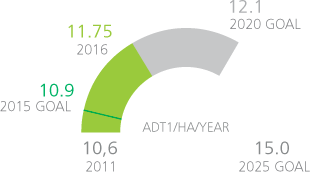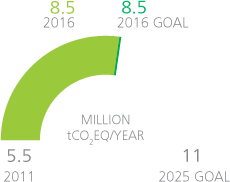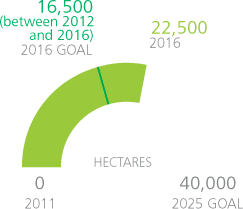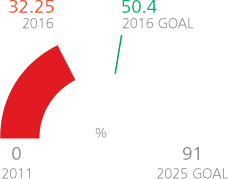In 2011, with the support of the Board of Directors and the Sustainability Committee, Fibria established its long-term goals. A set of commitments, prepared based on our strategic pillars and priority aspects for the company, that will guide Fibria until 2025.
Our goals aren't static and can evolve and receive new commitments, such as the goals defined in 2016 to reduce water consumption in our forest, nursery and industry operations.
Our objective for the long-term goals is to ensure the implementation of the strategy and sustainability of the business. See the results for 2016.
Objective: optimize the use of natural resources
Goal
Reduce by one third the amount of land needed for pulp production
How
Increasing productivity from 10 tons of pulp/ha/year in 2011 to 15 tons/ha/year in 2025, by means of:
techniques of classic genetic improvement and of silviculture
improvement of forest management
increased industrial productivity
Benefits
lower concentration of land ownership
greater availability of land for other uses
increased competitiveness and greater return to shareholders

1 Air-dry ton.
NOTE: there are no annual goals, only every 5 years.
Objective: contribute to mitigation of greenhouse gases
Goal
Double carbon absorption from the atmosphere
How
Increasing net sequestration from 5.5 million tCO2eq/year in 2011 to 11.1 million tCO2eq/year in 2025, through:
increase in forest areas (eucalyptus forests and conservation areas)
restoration of degraded areas with native species
Benefits
reduction in concentration of greenhouse gases in the atmosphere

NOTE: net annual sequestration of carbon from the atmosphere is defined by the difference between total sequestration of planted and native forests and direct and indirect carbon emissions from forestry, industrial, and logistics operations throughout the pulp production cycle, from nursery to client.
Objective: protect biodiversity
Goal
Promote the environmental restoration of 40,000 hectares of own areas between 2012 and 2025
How
planting native forest species
promoting and implementing natural regeneration of native species
eliminating degradation factors and exotic species
Benefits
enrichment of wildlife and flora, including endangered species, in the Atlantic Rainforest and Cerrado Biomes
expansion of environmental services - carbon sequestration and water availability and quality, among others - of areas whose original characteristics were altered due to human activities

NOTE: this goal does not consider Fibria's support to restoration projects in third-party areas, developed through agreements with other entities.
Objective: increase eco-efficiency
Goal
Reduce by 91% the volume of industrial solid waste disposed of in own or third-party landfills
How
Reducing from 60 kg/ton of pulp produced in 2011 to 5 kg/ton of pulp produced in 2025, through:
reduction of waste generation in mills
reuse of waste in the soil
Benefits
reduction of impacts and risks from industrial landfills
increased eco-efficiency in the company's production processes
cost reduction for waste disposal and substitution of inputs

1 Waste generation increased between 2016 and 2017 and we had difficulty marketing it. While the results for 2016 proved unfavorable compared with the previous year, initiatives and investments made indicate a long-term reduction in disposal of waste in landfills This implies that, in coming years, results will be balanced given the ongoing initiatives.
Objective: strengthen interaction between company and society
Goal
Achieve 80% approval in neighboring communities (read more on page Favorability Survey)
How
Raising the approval rate in neighboring communities from 50% in 2011 to 80% in 2025, through:
improvement in the quality of relationships with communities
support to local development projects
inclusion of the community into the company's value chain
Benefits
harmonious coexistence with neighboring communities
environment conducive to local development

NOTE: approval rate measured through surveys conducted every three years.
Goal
Help communities make self-sustaining 70% of income-generation projects supported by companies
How
Evolving from 5% of self-sustaining projects in 2011 to 70% in 2025, through:
expansion of the Rural Land Development Program (PDRT) model
promotion of technical and managerial training, through consulting companies and partnerships
attraction of support from other partners
Benefits
social inclusion of communities, reducing their social and economic vulnerability
protagonism of the community in its development process
increased managerial and technical qualification of community members
autonomy of communities in relation to private and public sectors
stimulus to the development of social capital
reduction of conflicts and maintenance of good coexistence with neighboring communities

Objective: Optimize water management
Fibria has set a long-term goal for water. The goal unfolds in the forestry, nursery, and industry fronts.
WATER IN THE FOREST (2017-2025)
Carry out water management in micro watersheds in Fibria's forests and disseminate technical know-how on the subject to our neighbors in critical watersheds.
NURSERIES (2017-2025)
Reduce by 17% water consumption per seedling produced (liters/seedling produced).
INDUSTRIAL OPERATIONS (2017-2025)
Reduce by 17% water consumption per ton of pulp produced (m³ of water/ton of pulp)
